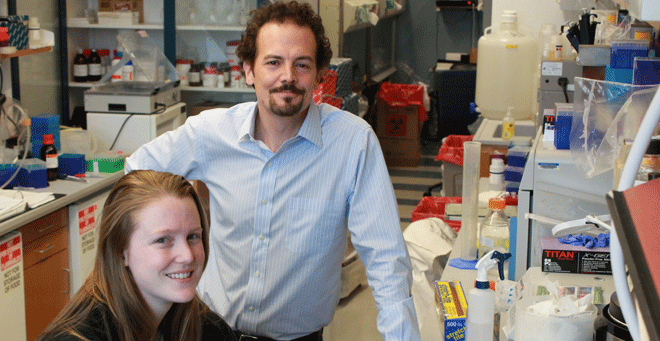 |
|
|
Abraham L. Brass, MD, PhD, and Jill Perreira |
Researchers at UMass Medical School have identified a new life cycle stage in HIV infection, thanks to a novel technique they developed to take images of intact infected cells. They’ve shown that this phase of infection, dubbed intra-nuclear migration, by principal investigator Abraham L. Brass, MD, PhD, relies on the human protein CPSF6 to guide the virus through the host cell’s nucleus and position it at active genes where it prefers to make its home. Details of HIV’s intra-nuclear migration and the imaging techniques used to find it were published in Cell Reports.
“This study reveals an important stage and mechanism in HIV infection that was previously unappreciated,” said Dr. Brass, assistant professor of microbiology & physiological systems. “It’s important to know more about these early infection events so we can come up with ways to stop the virus from becoming part of our DNA and infecting us for life.”
The key to learning about HIV’s intra-nuclear migration came thanks to a new technique, ViewHIV, which was developed by Brass and his colleagues, Jill Perreira and Chris Chin, both research associates at UMMS; and Eric Feeley, a PhD candidate at Duke University. Using ViewHIV, the researchers are able to closely monitor the migration of HIV, which is made up of a protein capsule or capsid that contains the virus’s DNA, as it passes through the nuclear membrane and moves around inside the nucleus. Up to this point, scientists have been unable to generate good images of HIV inside the nucleus using standard techniques. Because of this limitation, most insights into HIV’s transit across the nuclear membrane have been gained through indirect molecular biology and biochemistry methods that evaluate large cell populations.
“There are certain characteristics of a virus you can only learn about by keeping it intact and seeing it in action in single cells,” said Perreira, a co-lead author on the study. “Researchers have been studying HIV for 30 years, but we still didn’t have a really good way to look inside infected cells. We thought that if we could just see what’s going on, then we could get a better idea of what the virus is doing and how to stop it.”
To take a look inside HIV-infected cells, the team developed ViewHIV. Adapted from existing technologies, ViewHIV is capable of generating images of both the viral genome and protein capsid simultaneously inside an infected host cell. ViewHIV pairs a very sensitive type of fluorescence in situ hybridization (FISH) with a monoclonal antibody that binds to the viral capsid. The key, according to Brass, was using a protease in preparing the samples. This allowed the capsid, tagged with a fluorescent antibody, to be seen in the images of the nucleus.
This technique allows scientists to visualize the movement and fate of the viral capsid, DNA and RNA inside the cell. Standard confocal microscopy is then used to take both horizontal and vertical photos of the cell that are re-assembled into detailed three-dimensional images of the cell.
Perreira and Chin, using the images produced by ViewHIV, were able to track the virus and its capsid as it moved through the cytoplasm, across the nuclear membrane and finally into the nucleus where it permanently integrates into the host cell’s DNA. By knocking down certain host proteins, the researchers were able to observe what impact these proteins had on the virus’ ability to enter the nucleus and integrate into the host genome.
They found that the viral capsid played an important role in the virus’s ability to enter and navigate through the nucleus. Many studies hypothesized that HIV shed it protein capsid before it enters the nuclear pore complex. Brass’s images clearly show that a portion of the capsid is still present and associated with the viral DNA after nuclear entry, with the final shedding of capsid occurring when the virus reaches its final destination. Further investigation showed that it is the capsid’s use of the host proteinsCPSF6 and TNPO3 that allow it to enter and navigate through the nucleus. Without this help, the virus gets stranded outside or at the edge of the nucleus.
The CPSF6 protein normally works to modify the cell’s newly made messenger RNAs and its goal is to find active genes once it gets into the nucleus. Brass’s study shows that when a cell is infected with HIV, the virus takes advantage of CPSF6 by hitching a ride on the protein, which is ferried across the nuclear membrane by the nuclear importer, TNPO3. Once inside the nucleus, HIV—because it’s bound to CPSF6 —is carried to active gene areas where it prefers to integrate. In the absence of TNPO3, the virus is unable to cross the nuclear membrane. And without CPSF6, it is unable to find the active gene regions that it prefers for integration. Instead it integrates into less active regions.
These findings point to a previously undescribed state in HIV’s life cycle taking place between the time the virus enters the nucleus and the time its DNA is integrated into our genome, which was only discovered thanks to the development of ViewHIV.
“We believe ViewHIV is going to be a great tool for unlocking the mechanisms that govern the early state of HIV’s life cycle,” said Brass. “With our technique we can better determine how HIV establishes itself into our DNA and develop new ways to stop that from happening.”